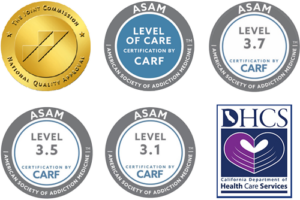How Long Does Crack Stay in Urine?
If you’ve ever asked the question, “how long does crack stay in urine?”, this guide helps answer everything you need to know about crack cocaine, urine drug tests, and more.
Crack cocaine, a potent and highly addictive stimulant, presents significant challenges for both users and those involved in drug testing and treatment. Understanding the detection windows for crack cocaine is crucial for various applications, including medical treatment, employment screening, and legal proceedings. This blog explores the different methods of drug testing and the factors influencing the detection times of crack cocaine and other drugs used in the human body, providing valuable insights for professionals and individuals alike.
What is Crack Cocaine?
Cocaine is a powerful stimulant drug that affects the central nervous system. It is known for its ability to produce intense euphoria, increased energy, and heightened alertness. Cocaine is typically found in two forms: a white powder, which can be snorted or dissolved and injected, and a crystalline form known as crack cocaine, which is smoked.
Cocaine is derived from the leaves of the coca plant (Erythroxylum coca), which is native to South America. The indigenous peoples of the Andes have chewed coca leaves for centuries for their stimulating effects, which help reduce fatigue and hunger.
Crack cocaine is a potent, highly addictive form of cocaine that is processed to create a rock crystal, which can be smoked. Originally, it was developed to convert powdered cocaine — using household chemicals like baking soda — into a more easily used and marketed drug and was often sold on street corners. Crack can be sold in small, affordable quantities, making it accessible to a broader range of users and increasing potential profits for dealers.
How is Crack Cocaine Produced?
Crack cocaine is made by dissolving powder cocaine in a mixture of water and baking soda or ammonia, then heating the solution to form the solid “crack” crystals. The name “crack” comes from the crackling sound it makes when heated. Smoking crack cocaine delivers a rapid and intense euphoric effect due to its quick absorption into the bloodstream through the lungs, leading to a powerful, immediate high. However, this high is short-lived, often lasting only a few minutes, which can lead to frequent use and a high potential for addiction or other drug abuse factors.
How Can I Identify Crack Cocaine?
Crack cocaine has distinct physical characteristics that can help in its identification. Here are some key features and considerations:
Appearance
- Color and Texture: Crack cocaine typically appears as off-white to beige-colored crystals or rocks. These rocks have a hard, brittle texture and can vary in size.
- Shape: The substance often comes in small, irregularly shaped chunks or rocks. These can range from small pebble-sized pieces to larger, more solid chunks.
Sound
- Crackling Noise: When heated, crack cocaine makes a distinctive crackling or popping sound, which is how it got its name. This noise occurs when the substance is smoked.
Packaging
- Common Forms of Packaging: Crack cocaine is usually packaged in small plastic bags, vials, or aluminum foil. The packaging is often designed to be discreet and easily concealed.
- Small Quantities: It is often sold in small quantities, making it more accessible and affordable for users.
Usage Paraphernalia
- Pipes: Users typically smoke crack cocaine using small glass pipes, often referred to as “crack pipes.” These pipes may have residue or burn marks.
- Makeshift Tools: Sometimes, users may improvise with makeshift smoking devices, such as soda cans or metal pipes.
How Long Can Crack Cocaine be found in Urine or Blood Tests?
To begin to answer the question of how long does crack or crack cocaine stay around in your system, it is critical to understand how your body processes cocaine and other substances. This time period is dependent on numerous factors, including:
- Body size and composition
- How long substance abuse has been ongoing
- Liver function
- Metabolic rate
- Route of administration (inhaling cocaine particles, smoking cocaine, or injecting a cocaine solution into veins)
- Age
- Genetic factors
- Underlying health conditions
- Drug interactions with other substances or drugs
The above factors contribute to the variability in how long cocaine stays in the body and affects an individual. If you’ve ever wondered, “how long does crack stay in your system?”, factors like metabolism and overall health can have a dramatic impact on how long medical professionals can detect crack cocaine.
What Happens in Your Body?
When cocaine is introduced into the body, it undergoes a series of metabolic processes that determine its effects and how long it stays in the system. Here’s an overview of how the body processes cocaine:
Metabolism
- Liver Metabolism: The liver plays a key role in metabolizing cocaine. The drug is broken down into several metabolites, with benzoylecgonine being the most prominent. Benzoylecgonine is often used as a marker in drug tests because it stays in the body longer than cocaine itself.
- Enzymatic Action: Cocaine metabolism is primarily facilitated by enzymes such as carboxylesterases in the liver. These enzymes break down cocaine into its metabolites.
Excretion
- Urine: The metabolites of cocaine are primarily excreted through urine. Benzoylecgonine can be detected in urine for several days after use, depending on the amount and frequency of cocaine consumption.
- Other Pathways: Cocaine and its metabolites are also excreted in small amounts through sweat, saliva, and feces.
Half-Life and Duration of Effects
- Cocaine’s Half-Life: The half-life of cocaine in the bloodstream is relatively short, typically around 1 hour. However, its metabolites, such as benzoylecgonine, have a longer half-life (approximately 6-8 hours), which extends the detection window.
- Duration of Effects: The duration of cocaine’s effects varies by the method of use. For example, the high from snorting cocaine may last 15-30 minutes, while smoking crack cocaine produces a shorter, more intense high that lasts about 5-10 minutes.
Key Takeaway
Depending on frequency of use, the user’s metabolism, and other factors, crack cocaine may stay in your system for as little as 6-8 hours or as many as several days.
This window of detection can mean that regular users often worry about drug tests. When you wonder, “how long does crack stay in your system?” , it may be time to explore drug detox treatment programs in your area.
Crack Cocaine Addiction: Signs and Symptoms
Addiction to illicit or prescription drugs, including cocaine and its derivative crack cocaine, produces a wide range of signs and symptoms. Cocaine use disorder symptoms typically manifest in the following ways:
Cocaine and crack cocaine use can lead to a range of physical, psychological, and behavioral symptoms. Recognizing these signs is crucial for early intervention and treatment of drug addiction.
Physical Signs
- Dilated Pupils: Cocaine use often causes the pupils to dilate (enlarge), even in well-lit environments.
- Increased Energy and Activity: Users may exhibit hyperactivity, restlessness, and an inability to sit still.
- Rapid Heart Rate: Cocaine can cause tachycardia, or a rapid heart rate, which may be accompanied by increased blood pressure.
- Decreased Appetite: Users often lose interest in food, leading to significant weight loss over time.
- Nosebleeds and Runny Nose: Frequent snorting of cocaine can damage nasal tissues, leading to chronic nosebleeds and a persistent runny nose.
- Burn Marks: Crack cocaine users may develop burn marks on their lips or fingers from using hot pipes.
- Muscle Twitches: Cocaine can cause muscle twitches, tremors, or other involuntary movements.
Psychological Symptoms
- Euphoria and Confidence: Cocaine use often produces intense feelings of euphoria, increased confidence, and a sense of invincibility.
- Paranoia: Chronic use can lead to paranoid thoughts, delusions, and even hallucinations, especially during binges.
- Anxiety and Restlessness: Users may experience heightened anxiety, nervousness, and an inability to relax.
- Irritability and Agitation: As the effects of cocaine wear off, users can become irritable, angry, and easily agitated.
- Depression: After the high wears off, users often experience a crash, leading to feelings of intense depression and despair.
Behavioral Signs
- Frequent and Unexplained Absences: Individuals with a substance use disorder may frequently miss work, school, or social obligations without explanation.
- Financial Problems: The high cost of cocaine and crack cocaine can lead to financial difficulties, including borrowing money, selling possessions, or stealing to fund the addiction.
- Secretive Behavior: Users often become secretive, hiding their drug use from others, and may go to great lengths to conceal their activities.
- Risky Behavior: Cocaine use can lead to risky behaviors, including unsafe sexual practices, driving under the influence, or engaging in illegal activities.
- Isolation: Individuals may withdraw from family, friends, and social activities, preferring to spend time alone or with others who use drugs.
Signs of Crack Substance Use Disorder
Crack cocaine, due to its potent effects and high addiction potential, can lead to a rapid development of substance use disorder. Signs specific to crack use disorder include:
- Intense Cravings: Users may experience overwhelming cravings for the drug, even after short periods of abstinence.
- Binge-Use Patterns: Crack users often engage in binge patterns, where they use large amounts of the drug in a short period, followed by a crash.
- Tolerance and Dependence: Over time, users need increasing amounts of the drug to achieve the same effects, leading to physical and psychological dependence.
- Neglect of Responsibilities: Severe neglect of personal and professional responsibilities, hygiene, and health often accompanies crack use disorder.
- Increased Risk of Overdose: The intense and compulsive nature of crack use increases the risk of overdose, which can be fatal.
Information About Drug Tests
Several drug testing methods can detect the presence of crack cocaine in the system, each varying in sensitivity, detection window, and application. Here are the most common types:
1. Urine Test
- How It Works: Urine tests are the most common method for detecting cocaine use. These tests look for the presence of benzoylecgonine, a metabolite of cocaine, rather than cocaine itself.
- Detection Window: Crack cocaine can be detected in urine for approximately 2-4 days after use. In heavy or chronic users, it may be detectable for up to a week or more.
- Usage: Urine tests are widely used in employment screenings, rehabilitation centers, and legal settings.
2. Blood Test
- How It Works: Blood tests measure the actual concentration of cocaine and its metabolites in the bloodstream. Cocaine is quickly metabolized and has a shorter detection window in blood compared to urine.
- Detection Window: Cocaine can be detected in blood for up to 12-48 hours after use.
- Usage: Blood tests are commonly used in situations requiring confirmation of recent use, such as in medical emergencies, impaired driving cases, or forensic investigations.
3. Saliva Test
- How It Works: Saliva tests detect the presence of cocaine in the oral fluids. Cocaine can enter the saliva directly or through the bloodstream, and the test identifies the drug and its metabolites.
- Detection Window: Cocaine can be detected in saliva for 24-48 hours after use.
- Usage: Saliva tests are non-invasive and are increasingly used for roadside testing, workplace drug screening, and in some legal contexts.
4. Hair Test
- How It Works: Hair tests analyze hair samples for traces of cocaine and its metabolites. As the hair grows, drugs are incorporated into the hair shaft from the bloodstream, creating a long-term record of drug use.
- Detection Window: Cocaine can be detected in hair for up to 90 days or longer, depending on the length of the hair sample. Each 0.5 inches of hair represents approximately one month of drug use history.
- Usage: Hair tests are used for long-term drug use detection, making them common in legal and forensic settings, as well as in some employment screenings.
5. Sweat Test
- How It Works: Sweat tests involve placing a patch on the skin that absorbs sweat over a period of days or weeks. The patch is then analyzed for the presence of cocaine and its metabolites.
- Detection Window: Sweat patches can detect drug use over the period the patch is worn, typically ranging from 7 to 14 days.
- Usage: Sweat tests are less common but are used in monitoring programs, such as those for parole or probation, to track drug use over time.
Various drug testing methods are available to detect crack cocaine, each with its strengths and limitations. Urine tests are the most commonly used to detect cocaine, due to their balance of sensitivity and convenience. Blood and saliva tests are preferred for detecting recent use, while hair tests provide a longer detection window for identifying past drug use. Understanding these methods can help individuals and professionals choose the appropriate test for their needs.
Commit to Treatment. Keep Your Job!

Get Help for Drug Abuse Problems
Crack addiction treatment is only a phone call away. Journey Hillside Tarzana uses a range of therapeutic tools to help crack cocaine users navigate customized drug detox treatment programs.For substance abuse disorders — even prolonged cocaine abuse — medically-assisted therapy, mental health, and individual counseling services can help individuals break free from the financial, social, and physical health risks associated with cocaine addiction.





